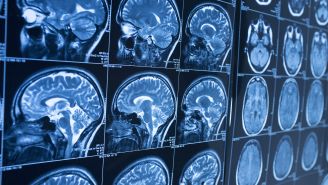Today, more than one million Americans live with Parkinson's disease (PD), a progressive movement disorder. It develops as nerve cells that coordinate muscle movement in the mid-brain die off, depleting a vital chemical messenger called dopamine. Despite being one of the most common neurologic conditions physicians see, Parkinson’s disease often comes with many ‘myths’ or misconceptions.
For example, Although Parkinson’s has no cure, physicians know that the disease can be successfully managed for a long time, and a PD diagnosis does not mean imminent death.
“People can live for many years after a Parkinson’s diagnosis,” says Jessica Hedeman, DO, a neurologist at Mercy Health Hauenstein Neurosciences Center in Grand Rapids, Michigan. “I’ve had patients with PD for 20-plus years.” Many options now exist for improving patients’ symptoms, she says, including better ways of delivering dopamine-restoring medications, as well as advances in deep brain stimulation that can ease some of PD’s movement-related effects, such as tremors, imbalance and slow, shuffling gaits.
Medication misconceptions
Perhaps, one of the most pervasive myths about Parkinson’s, Dr. Hedeman suggests, concerns drug resistance, which she labels “a huge misperception.” Unlike cancer patients who develop resistance to chemotherapy over time, PD patients do not develop resistance to their medications, she says, but they may need higher doses of a drug to manage symptoms as the disease progresses.
Parkinson's drugs do cause known side effects, among them nausea and involuntary movements called dyskinesia. “It has to do with how long you’ve had PD, the dose of drugs you’re on and susceptibility to dyskinesia,” Hedeman says. In patients diagnosed with Parkinson’s over 25 years ago, like actor Michael J. Fox, symptoms such as these may be severe, she adds. But in general, they’re usually quite mild, setting in after 5 or 10 years of taking a drug.
Another medication myth: that you should wait to take yours until your last dose wears off. Doctors advise against waiting, as dopamine-restoring drugs are most effective when taken at the same time each day. A medication timer may be helpful and is often recommended.
A question of age
When Fox was diagnosed in 1991, he was age 29, which highlights another common myth about Parkinson’s. Although advancing age, especially after age 60, is the biggest single risk factor for developing the disease, PD also can strike the young. An estimated 10 percent of cases are diagnosed in patients before age 50. When this happens, Hedeman says, there’s likely a genetic factor at play, one of several genes identified, so far, associated with increased vulnerability to the disease.
Tremor myths
Many people believe all Parkinson’s disease patients have tremors. While the large majority do, a sizable percentage of those who develop PD present with other symptoms, as well, according to Hedeman. “Parkinson’s is hugely individual in how it manifests,” she says, with non-motor symptoms often predating the onset of motor symptoms by many years. These include changes in sleep patterns, the sense of smell or even the voice, as well as dizziness, fainting and constipation. However, you must present with bradykinesia—a slowing of movement—plus tremor or rigidity for your doctor to consider a diagnosis of PD.
What's more, having tremors does not always mean you have PD. Essential tremor, a separate disorder that causes parts of your body to shake, is far more common than PD. It carries a strong family connection and may start in one hand and progress to the other, Hedeman says. When your doctor is determining whether you have Parkinson's, having essential tremor can make it more difficult. For specific cases where diagnosis is particularly tough, some physicians may turn to scanning technologies that allow them to measure dopamine uptake in the brain. Reduced dopamine levels mean a likely PD diagnosis.
What people don't know about PD
Although not a myth or misperception, the pain Parkinson’s disease can cause often comes as a surprise to many of her patients, Hedeman notes. “There’s a high association with pain” in PD, she says. “Parkinson’s doesn’t just mean you have tremors or a shuffling gait,” but it also causes limb stiffness that can trigger painful episodes over time.
Fortunately, physicians can help manage that pain, she adds, much as they manage other symptoms in this complex disease. And, while exhaustive research has not yet found a way to slow PD progression, she adds, investigators are still actively pursuing that goal.






